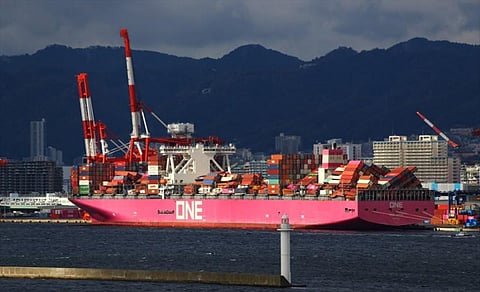

A friend of mine, a pilot in Townsville, invited me to join him during an inbound pilotage of a car carrier back in the 1980s. The bridge is forward on car carriers and there was a strong crosswind on the day. My friend said the trick in bringing in these high windage ships was to never look back. I sneaked a quick look aft to see what he was talking about. The ship was coming down the channel, crabwise at an angle of about 30 degrees to its path.
I've never forgotten that experience. Every time I see a car ship or a container ship stacked to the heavens presenting such a big windage profile I think of that experience on the car ship.
As soon as I heard the circumstances surrounding the grounding of Ever Given in the Suez Canal, my immediate thought was "it had to happen". The high windage area of containerships as they continue to grow in size causes one to consider this ever-growing problem. Even back in the 1970s on much smaller ships I can remember steaming along with a list caused by wind on the beam.
Containers are stacked so high on today's mega-carriers that they make car carriers almost small by comparison. Given the millions of dollars lost during this grounding, one questions if ship sizes have outgrown the canal? The canal, at the point of grounding, was 300 metres wide. Ever Given is 400 metres long.
Which brings me do the other topic that is of concern. The high stacking plans on modern ships.
When Malcolm McLean introduced standard containers in the 1960s, he revolutionised ships' cargo-carrying capability. Better security of cargoes and quicker turnarounds resulted almost immediately. But he probably never conceived that container ships would become so big. Even his mighty 33-knot SL7 Sealanders only carried containers three-high on deck. Today they are stacked up as high as eight levels.
Container losses are on the increase. The ONE Apus collapse last December is only one of the most recent embarrassing and extremely costly losses. YM Efficiency's losses of 60 containers off Newcastle is another of the many lashing failures attributed to heavy weather. The list goes on: APL England, Rena, and Napoli. Even the breaking in half of MOL Comfort and its 4,293 containers has been thought to be due to misdeclared container weights (although the evidence is lost forever).
The reasons for these losses are hard to quantify. Certainly, accelerations at great heights above the ship's centre of gravity are the cause. But why are some parts of the cargo stack unaffected?
Were the twist locks a standard pattern? That is, a quarter turn to the left to lock? I have encountered, during my surveying days, non-standard twist locks that are opposite-handed to the standard ones. That is, a quarter turn to the right to lock.
The problem is obvious; the observer could think they are locked when they're not.
Then there are the lashings themselves. Are they always fully tensioned up? During my time on containerships, I can confirm that lashings are often left loose. The constant clanging at night is a testimony to this. And these big ships do bend. Which causes the lashings to become loose.
There are any number of reasons why a shipper's valuable cargo doesn't reach him. Another serious issue is the undeclared container contents such as dangerous goods, flammables or simply the weights in the containers themselves. Even incorrect packing of containers can cause failures. Years ago, the sight of a forty-footer broken in half, the result of incorrect packing, starkly reminds me that incorrect loadings can be dangerous and costly.
Often ships officers don't have any idea of the container weights particularly in high stacks. In fact, they only hope that their entries in the stability programs can be accounted for within the constraints of the ship's GM. The World Shipping Council (WSC) pushed for mandatory verification of container weights prior to loading and in 2016 the SOLAS convention was amended to mandate the verification of the gross weight of containers. But this has not been particularly well enforced, if at all. Container weights continue to be poorly estimated or wrongly estimated.
Obviously, a heavy weight, high in the stack and accelerated during a heavy roll, can and does cause lashing failures.
The economy of scale of these huge mega carriers is only the tip of the iceberg when it comes to possible losses.
The WSC has made efforts to estimate the number of containers lost overboard each year. A recent study of their 15,000 members concluded that, on average, 1,372 containers in total are lost overboard each year. This figure is at odds with anecdotal figures of upwards from 2,000 containers. ONE Apus lost 1,812 containers alone, which makes the WSC figures questionable.
Bear in mind that these figures are for containers lost overboard. It doesn't account for containers in collapsed stacks still remaining on board. That's the figure that interests cargo underwriters.
Catastropic container losses are becoming more prevalent. ONE Apus was a fairly big ship, about 20,000 TEU. The mega-carriers approaching 23,000 TEU are increasing in number. Currently there are about 266 million containers shipped each year, a figure that is almost double the number shipped fifteen years ago. I believe we will see more losses in the future. Is there a need to improve lashing arrangements on mega-carriers?
The rapid growth of containership sizes throws up more problems than purely getting cargo from A to B as cheaply as possible. The failure of lashings and the Suez Canal issues are just another consequence of the economy of scale.
